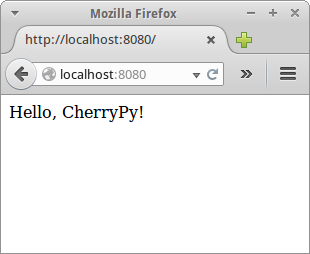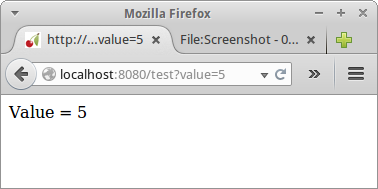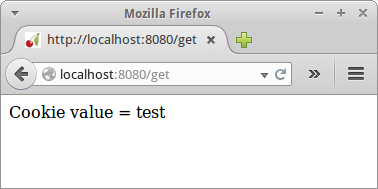CSC/ECE 517 Fall 2014/ch1a 3 zq
CherryPy Framework
CherryPy is a python based, object-oriented web framework that enables developers to quickly create lightweight and fast web applications.<ref>http://www.cherrypy.org/</ref><ref>http://en.wikipedia.org/wiki/CherryPy</ref>
Some of the popular websites using it are Hulu<ref>http://tech.hulu.com/blog/2013/03/13/python-and-hulu/</ref> and Netflix<ref>http://techblog.netflix.com/2013/03/python-at-netflix.html</ref>. The full list of applications using it can be found here.<ref>http://docs.cherrypy.org/en/latest/intro.html#websites-running-atop-cherrypy</ref>
Background
Object-oriented, python based
Basic RFC 7321 (HTTP)
Built-in profiling
complete test suite
No built-in templating or database engines, use external tools
Why, when, where and by whom was it developed ?
Basic Philosophy Behind the project ?
Which companies are using it ?
Total number of active users, latest release version number etc.
Basic Example
The following code demonstrates the most basic webserver using the CherryPy framework.
import cherrypy
class WebApp(object):
@cherrypy.expose
def index(self):
return "Hello, CherryPy!"
cherrypy.quickstart(WebApp())
Run the application, and open your web browser to localhost:8080. The following page is displayed
Features
In-built HTTP Server to host single or multiple applications
CherryPy comes with its own HTTP server which can be used to host web applications.
Single application
The easiest way to do that is by calling the cherrypy.quickstart() function. The function takes at least one argument.
cherrypy.quickstart(WebApp())
This starts the application 'WebApp' at http://localhost:8080/.
It can also take 2 more arguments.
cherrypy.quickstart(WebApp(), '/hello', {'/': {'tools.gzip.on': True}})
This starts the application 'WebApp' at http://localhost:8080/hello. The third argument defines the configuration for our application. It can either be a dictionary object or a file.
Multiple applications
The function cherrypy.tree.mount is used to host multiple applications.
cherrypy.tree.mount(MyApp1(), '/app1', app1_conf) cherrypy.tree.mount(MyApp2(), '/app2', app2_conf) cherrypy.engine.start() cherrypy.engine.block()
This will host two applications having paths http://localhost:8080/app1 and http://localhost:8080/app2.
Logging
CherryPy provides the following method for application logging
cherrypy.log("Hello, CherryPy!")
By default, all logging is written to the console. The configuration keys log.access_file and log.error_file are also available for writing logging and errors to a text file.
Query Strings
CherryPy will automatically parse the query string of a URL. Fields are passed as method arguments with matching names, and can take advantage of default argument values.
import cherrypy
class WebApp(object):
@cherrypy.expose
def test(self, value=1):
return "Value = " + str(value)
cherrypy.quickstart(WebApp())
A URL of localhost:8080/test?value=5 gives the following
Cookies
CherryPy can set browser cookies with cherrypy.response.cookie and read browser cookies with cherrypy.request.cookie by accessing these variables as python dictionary objects.
import cherrypy
class WebApp(object):
@cherrypy.expose
def set(self, value = "Test"):
cookie = cherrypy.response.cookie
cookie['Value'] = value
return "Cookie set"
@cherrypy.expose
def get(self):
cookie = cherrypy.request.cookie
return "Cookie value = " + str(cookie['Value'].value)
cherrypy.quickstart(WebApp())
Navigating to localhost:8080/set?value=test followed by localhost:8080/get gives the following
Sessions
In CherryPy, sessions are disabled by default. To enable sessions, set the configuration tools.sessions.on to True. <ref>http://docs.cherrypy.org/en/latest/basics.html#using-sessions</ref>
Session variables can be accessed with cherrypy.session, which is a python dictionary object.
import cherrypy
class WebApp(object):
@cherrypy.expose
def index(self):
if 'number' not in cherrypy.session:
cherrypy.session['number'] = 0
else:
cherrypy.session['number'] += 1
return "Number = " + str(cherrypy.session['number'])
cherrypy.config.update({'tools.sessions.on': True})
cherrypy.quickstart(WebApp())
This example shows a number that increments by 1 every time the user navigates to localhost:8080.
Server Configuration
The cherrypy.config.update function can be used to configure the HTTP server.
import cherrypy
class WebApp(object):
@cherrypy.expose
def index(self):
return "Hello, CherryPy!"
cherrypy.config.update({'server.socket_port': 9090})
cherrypy.quickstart(WebApp())
This will start the server on port 9999 instead of the default port 8080. The application can then be accessed at http://localhost:9999/.
We can also pass a file (containing configuration) as an argument to this function.
cherrypy.config.update("WebAppServer.conf")
WebAppServer.conf
[global] server.socket_port: 9999
Serve Static Content
Static contents like files, images, stylesheets etc. can be easily served by adding the following lines in the the application configuration file.
[/images] tools.staticdir.on = True tools.staticdir.dir = "/site/public/images"
This will allow us to access some file "user.jpg" present in the folder "/site/public/images/user.jpg" using the url http://localhost:8080/images/user.jpg.
Publish REST APIs
It allows to expose our APIs as Restful Web Services.
import cherrypy
class MyAppRestMode(object):
exposed = True
def GET(self):
return "Hello, CherryPy!"
conf = {
'/': {
'request.dispatch': cherrypy.dispatch.MethodDispatcher(),
'tools.response_headers.on': True,
'tools.response_headers.headers': [('Content-Type', 'text/plain')],
}
}
cherrypy.quickstart(MyAppRestMode(), '/', conf)
This exposes the REST API "GET": http://localhost:8080/. The API returns the string "Hello, CherryPy!".
Multiple HTTP Servers
It is possible to host the application with multiple servers, where each server runs on a different port.
from cherrypy._cpserver import Server server = Server() server.socket_port = 443 server.subscribe() cherrypy.quickstart(WebApp())
The above code hosts our application with one more server which runs on port 443. We can create any number of additional servers.
Test Suite
References
<references/>


